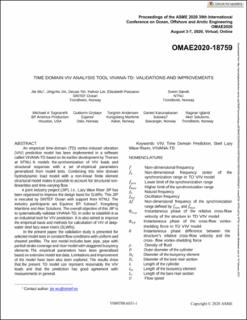| dc.description.abstract | An empirical time-domain (TD) vortex-induced vibration (VIV) prediction model has been implemented in a software called VIVANA-TD based on its earlier development by Thorsen at NTNU. It models the synchronization of VIV loads and structural responses with a set of empirical parameters generalized from model tests. Combining this time domain hydrodynamic load model with a non-linear finite element structural model makes it possible to account for structural non-linearities and time-varying flow. A joint industry project (JIP), i.e., Lazy Wave Riser JIP has been organized to improve the design basis for SLWRs. This JIP is executed by SINTEF Ocean with support from NTNU. The industry participants are Equinor, BP, Subsea7, Kongsberg Maritime and Aker Solutions. The overall objective of this JIP is to systematically validate VIVANA-TD, in order to establish it as an industrial tool for VIV prediction. It is also aimed to improve the empirical basis and methods for calculation of VIV of deep-water steel lazy wave risers (SLWRs). In the present paper, the validation study is presented for selected model tests in constant flow conditions with uniform and sheared profiles. The test model includes bare pipe, pipe with partial strake coverage and riser model with staggered buoyancy elements. The empirical parameters have been generalized based on extensive model test data. Limitations and improvement of the model have been also been explored. The results show that the present TD model can represent reasonably the VIV loads and that the prediction has good agreement with measurements in general. | en_US |
